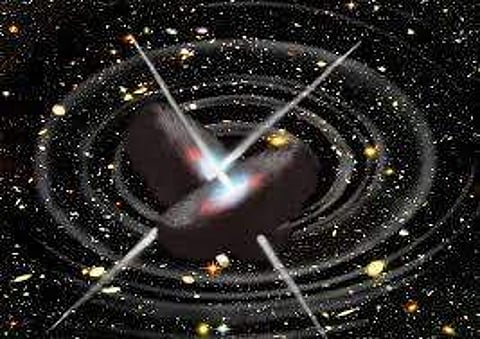

Researchers from the Indian Institute of Technology-Hyderabad will be looking for a monster black hole. They will shift reams of data from the most powerful and country's largest Giant Metrewave Radio Telescope (GMRT) Observatory, operated by the National Centre for Radio Astrophysics telescopes to precisely measure the clock periods of a collection of radio pulsars.
As a part of an Indian initiative, Indian Pulsar Timing Array (InPTA) - a consortium of Indian institutes based mainly at NCRA-TIFR, TIFR(Mumbai), RRI, IMSc, and IIT-H with about 25 research scientists including two from IIT-H and students from 15 institutions in India and abroad will be searching for nanoHz Gravitational waves. This is after, researchers from India became a full member of the international effort to discover and study very-low-frequency gravitational waves from monster black holes going around each other in orbit, IIT Hyderabad said. The unique frequency range of the GMRT, which is the largest steerable radio telescope at low radio frequencies, is helping to improve the precision of IPTA to detect nanohertz GWs.
When discovered, these waves will refine evolutionary models of our universe as well as masses and orbits of members of our solar system and open a new window of GW astronomy. These clocks are observed between 300 - 800 MHz with the GMRT, which is not covered by other big IPTA telescopes. The inclusion of GMRT will allow removing the delays introduced by the interstellar medium in the arrival of radio pulses from these Galactic clocks by a factor of 5 more precisely than before, which should becrucial to improve the precision of IPTA. Therefore, the InPTA and the GMRT are likely to play significant roles in the detection of nanohertz GWs and gravitational astronomy with these waves in future. Dr Shantanu Desai, Associate Professor, Dept. of Physics, IIT-H and part of the research project said, "IITH has been part of the Indian Pulsar Timing array since 2017. Our students participate in the data collection using the unique capabilities of the GMRT and are playing an important role in ongoing data analysis in partnership with NCRA-TIFR."
"Now that we are part of the global international effort to search for nanoHz gravitational waves, it provides plenty of opportunities for IITH students from science as well as engineering backgrounds to join this global effort to join this search and make groundbreaking discoveries,-" Dr Shantanu added.
